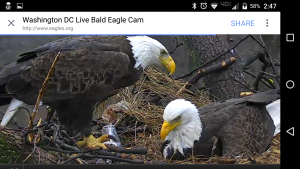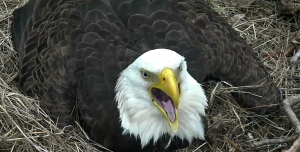 photo © 2016 American Eagle Foundation, EAGLES.ORG
photo © 2016 American Eagle Foundation, EAGLES.ORG
I was going to write this week’s blog about the universal truth in memoir writing—how the more specific we are in telling our stories, the more our writing transcends the personal and strikes a universal chord. I started the article last week and even gathered examples from memoirs to show you what I mean by universal truth. But then I fell into an eagles’ nest, and I haven’t emerged since.
How did I fall into an eagles’ nest? Two mated bald eagles, dubbed “The First Lady” and “Mr. President,” are nesting in a tulip poplar tree in the National Arboretum in Washington, DC. “The First Lady” laid two eggs in February, and she and “Mr. President” have been taking turns incubating their eggs since.
I know this because I have seen it. And I have seen it because The American Eagle Foundation installed high definition cameras—live cams—in the nest tree that stream the Eagles’ doings 24/7. My friend Nancy shared the link on Facebook last week. It caught my eye because my Transform Your Writing/Transform Your Life mentoring client Lydia McGranahan is threading an extensive eagle metaphor through her memoir.
So I clued her in to live cam with a nudge nudge to consider writing a short piece inspired by “The First Lady” and “Mr. President” for River Teeth’s “Beautiful Things” column. But I have become so smitten with eagles from her writing and the work we are doing together that I found myself tuning into the live stream on my phone, which has been propped next to my computer streaming the eagles’ nest for days now.
As I write this, one of the eagles (I still can’t tell Mama and Papa apart) just turned the eggs with its beak.
 photo © 2016 American Eagle Foundation, EAGLES.ORG
photo © 2016 American Eagle Foundation, EAGLES.ORG
Earlier today, Lydia informed me via email that eagles turn their eggs so the embryo doesn’t stick to the inside of the shell. She went on to say:
I learned all about eggs a few years back from a home school project I did with my girls. We incubated chicken eggs. We had to manually turn the eggs three times a day inside the incubator. Once the little chick poked through the shell with its egg tooth, we had to let it break out the rest of the way on its own, sometimes watching it struggle for hours. In the wild the parent does NOT help the chick break out. That’s because if a chick or eaglet is helped out of the egg then it will not have the opportunity to build up its own strength. The work that it takes to break free is what makes it strong enough to survive once it is free.
When I read this short paragraph in her email my mouth fell open. This writing—dashed off in an email—expresses the emotional truth of her narrator’s coming-of-age experience. I felt it in my heart. Talk about extended metaphor! She’s worked with the eagle metaphor long enough now that it shows up when she—or her story—needs it. Ah, the power of metaphor to raise our truths to an artistic expression.
Yesterday I sent the live cam link to one of my closest writing friends because she was sick and I thought eagles might be just the medicine she needed—
(Hee!!!! The eagle that is now on incubating duty just yawned! The inside of that yellow beak is pink. And did I just see a tongue?)
 photo © 2016 American Eagle Foundation, EAGLES.ORG
photo © 2016 American Eagle Foundation, EAGLES.ORG
When I called my writing friend today to check on her, she said she saw “The First Lady” and “Mr. President” talking to each other, which inspired a poem that she’s started writing.
My favorite thing about the eagles? The way they use their beaks to pull grass from their nest in closer to their bodies, an act that looks to me like they are tucking themselves—and their eggs—in. A more boring way of saying this is that it looks to me like an act of safety and security. No surprise that the question I am exploring in my own writing right now is Will I ever feel safe in my female body?
My point? Writing is, ultimately, about seeing. The way we see things outside of ourselves often provides an artistic way into our material, which is by nature hard to see. By watching—really watching—something as benign as bald eagles that seems completely unrelated to our material, we might just light upon a new way of giving expression to an aspect of our material that had previously eluded us.
So today I share with you a link to “The First Lady” and “Mr. President,” whose eggs are expected to begin hatching any minute, if they haven’t already. I encourage you to take time to tune in and watch them for a while. (Access the live cam here.) What strikes you about their behavior? What do you notice in their habitat and way of being? This one thing may just hold the beginnings of a poem or a “Beautiful Things” column, or it may provide a way in to the next segment of your memoir.
I expect that whatever it is you see in the eagles’ nest—the way they turn their eggs or pull their nest in close or “talk” to each other—will ultimately give you an artistic way of saying something you’ve always wanted to say.
For Lydia? Writing that short email paragraph about the incubation process brought her to tears. Of course it did. By writing about the way wild bird parents help their baby birds grow strong enough to survive, she wrote straight to the heart of her memoir, which is really about survival and freedom and one woman’s ability to, against all odds, hatch her unique and powerful Self into the world.
Which ends us on a note of universal truth, after all.

Wow! beautiful in so many ways! Thank you for stopping and observing the eagles so that we too may enjoy the process of becoming-in all that we are!!! Many blessings and hugs! Lisa Hadden
It’s so true that the more we slow down the more we become who we are–isn’t it, Lisa? And, of course, the more we SEE with our writing eyes. xo, M
Another great story Marilyn. I heard of these eagles but until now did not view them. I watched bald eagle cams in prior years and the thing that strikes me the most is their incredibly patience – sitting for hours and hours watching and guarding but have those babies tucked in close and safe. And their gentleness. Such huge birds so carefully and tenderly turning over the eggs. Patience and simply being in the moment. I will now be watching Mr. President and The First Lady with joy. Thank you.
Ah, yes, Katherine: patience. Another means of slowing down and being in the present–the eagles simply being what they are–rather than hurrying up life’s processes. A lesson in “divine timing” tucked into this nest, too, then? OH! As I type this the first egg has a crack! HEEEEEE!!!!!!
Heee! I love this, Marilyn. What I see in the Eagle nest is rest, and trusting, and courage — the knowing you’ve done everything you can and sitting and waiting and hoping for how it will turn out (all of which are of course huge themes for me in my life right now).
It is so true that we color our external experiences with our internal experiences. In many ways we spend our whole life “telling it slant”. 🙂
So true, Jessica! Our experience does indeed “slant” how we see things. And isn’t this why witnesses often see such different “truths” at the same scene? xo, M
I discovered bird cams through the Cornell Lab of Ornithology, the other year. I understand the addiction! For me, the Laysan Albatross speaks metaphor. These nests are on Kauai. Paradise? While the parents tend the egg long and well, after the chicks are a couple of weeks old, the are left while the parents go off to sea for many days before returning to feed them squid oil. The cycle repeats
Somehow the chicks grow and grow…
I’ll check out the Eagles, thank you for the link.
Universal truth for sure! Thanks, Marilyn, for the marvelous metaphor that nudges me a notch beyond my stuck place. Nourishing food for thought.